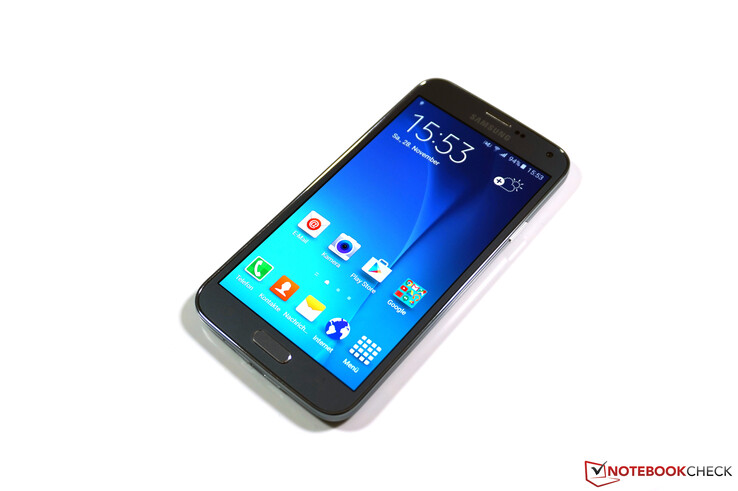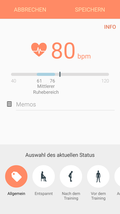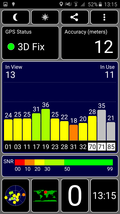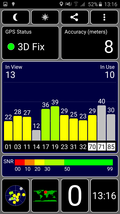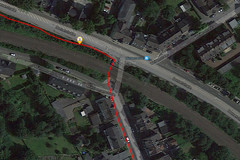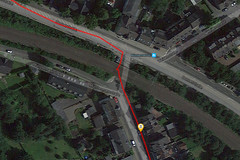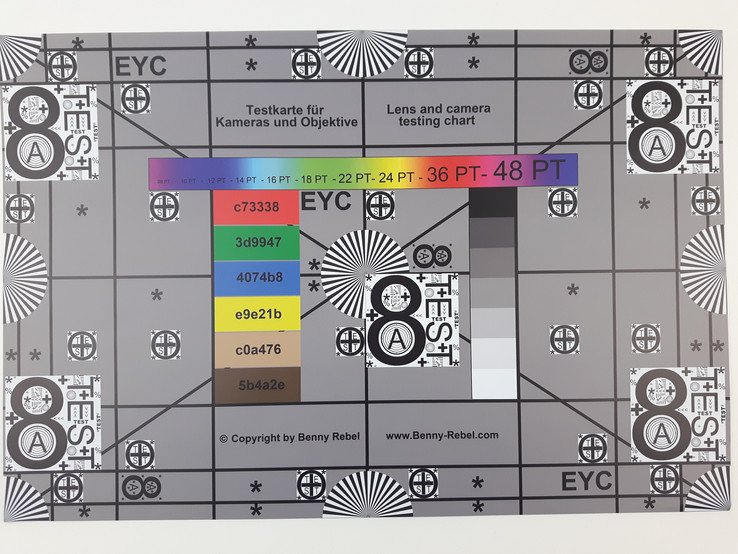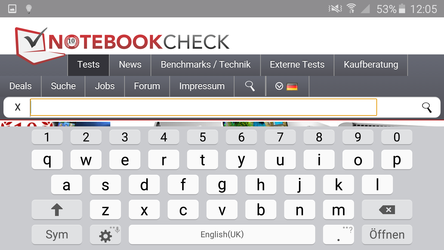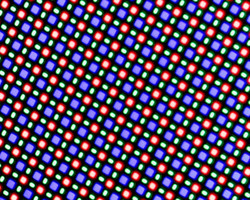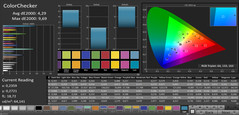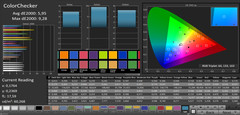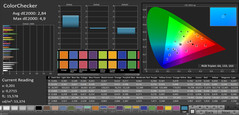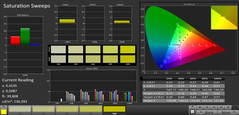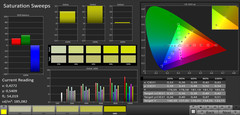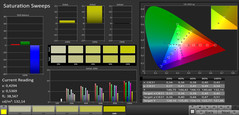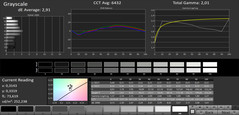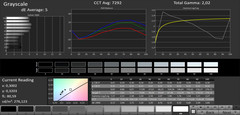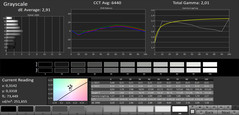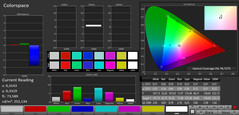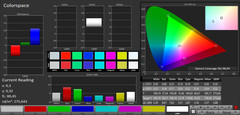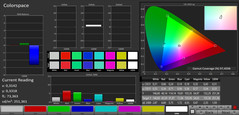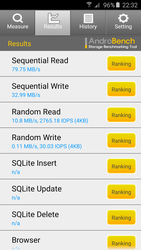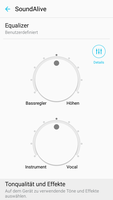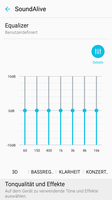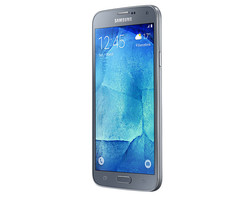Samsung Galaxy S5 Neo Smartphone Review

For the original German review, see here.
Unlike the previous generations, Samsung has not so far announced a Mini version of its flagship smartphone Galaxy S6. Instead, the Korean manufacturer now offers the Galaxy S5 Neo, which is based on the old top model Galaxy S5 for price-conscious users. On the outside, you can hardly distinguish any differences between the two devices, but there are some small changes. Samsung has discarded the Snapdragon 801 and uses its own Exynos SoC. There are some changes to the cameras as well, but some features have been removed. The Galaxy S5 Neo also takes care of two issues of the current S6, because besides the replaceable battery, you can now expand the storage via microSD-card.
Over the course of this review, we will obviously compare the results with the old Galaxy S5 and the current Galaxy S6. Other rivals for the review unit are the Huawei P8, the OnePlus 2 as well as the Motorola Moto X Play.
Case
You can immediately see that the review unit is a Galaxy S5, even though there are some small but important differences between the new S5 Neo and the Galaxy S5. For example, Samsung has dispensed with the fake leather back. The pattern is still there, but you can clearly see that the back is made of plastic. This creates a nice package, especially for our silver test sample, but you can also get the smartphone in gold and white. Fingerprints are not a big issue for the Galaxy S5 Neo.
The ports are a welcome improvement since they are now encapsulated, so you do not need the additional covers anymore. The smartphone is still dust-resistant and waterproof (up to 1 meter/~3 ft; for 30 minutes) according to IP67. The notification to close the back cover properly is rather annoying, because it appears after every restart.
The home button has also changed and there is no fingerprint reader anymore. The physical buttons are well integrated, but both the volume rocker as well as the power button are rather loud when you press them, which slightly affect the quality impression. We have already mentioned that you can remove the cover at the back to get access to the battery. The latter also has to be removed if you want to access the two slots for the SIM card and the SD-card (both Micro).
Once again, we can hear some quiet creaking sounds when we twist the device or apply a lot of pressure. However, we could not provoke ripples on the display and the overall stability is good. Overall, the case once again leaves a good impression, even though it cannot quite keep up with the sophistication and the stability of the new Samsung Galaxy S6.
Connectivity
We can find the biggest differences compared to the old top smartphone Galaxy S5 in this category. In addition the switch to Samsung's own Exynos SoC, which mean less performance, the features of the Galaxy S5 Neo are also reduced. Samsung has dispensed with the USB 3.0 port, the MHL connectivity, the Infrared transmitter, the support for the Chinese BeiDou satellite network as well as the previously mentioned fingerprint reader. What is left is USB 2.0, ANT+, NFC, Wi-Fi Direct as well as the heart rate monitor on the back. Accessories like the Samsung Wearables (Gear Fit, Gear S) still work. At least, the USB port supports USB-OTG and we had no problems when we attached a USB flash drive. The 16 GB internal storage can be expanded by up to 128 GB via microSD-card and compatible apps can be transferred to the memory card after the installation.
Software
The Galaxy S5 Neo is shipped with Android 5.1.1 and Samsung's own TouchWiz user interface. There is no information regarding if and when there will be an update to the current Android version 6.0. The other software additions are very similar to the larger sibling Galaxy S6 and the most important functions are covered. The Smart Manager allows quick access to the power settings and the device security. A swipe gesture from the left launches "Briefing", a news feed that is based on the popular Flipboard. In addition to the usual Google apps (Mail, Maps, Chrome, etc.), Samsung has once again installed the S Planner (calendar), S Health (fitness) and S Voice (voice control). You also get a special app store called Galaxy Apps. Furthermore, you get 100 GB OneDrive cloud storage for free for two years. The "Simple Mode" makes it easier to use the smartphone with a reduced home screen and larger symbols.
Communication & GPS
Unlike many current high-end smartphones, the Galaxy S5 Neo still uses a Micro-SIM. As well as quad-band GSM, the review unit supports quad-band UMTS and Hexa-band LTE (Cat.6: downstream up to 300 Mbps, upstream up to 50 Mbps). We could not notice any issues in the metropolitan T-Mobile network. Wireless networks are supported up to the fast Wi-Fi standard 802.11ac (2.4 & 5 GHz). Bluetooth 4.1 is supported as well. Once again, the download booster, which uses a Wi-Fi and LTE network simultaneously (download size at least 30 MB) is available.
We have already mentioned that the Galaxy S5 Neo does not support the Chinese BeiDou anymore, which was the case for the Galaxy S5, so the smartphone can locate you position via GPS and GLONASS. The positioning takes only a few seconds, both outdoors (accuracy down to 8 meters/~26 ft) as well as indoors close to a window (accuracy down to 12 meters/~39 ft).
We also checked the accuracy of the module on a bicycle ride and compared the results with the professional navigation device Garmin Edge 500. The total difference is just 100 meters (~328 ft). The smartphone shows some small deviations in the difficult sections like the turning point, but in general, the performance is still very good.
Telephone & Voice Quality
The phone app is very simple and is dominated by the large numbers pad. Besides the call history for incoming and outgoing calls, you have direct access to the favorites and the contacts. Within the app, you can also directly access the settings and block contacts or set up a call forwarding, for example.
The call quality leaves a good impression. Voices are very clear on both sides of the call and there is no annoying static. The position of the speaker at the back is not always perfect when you want to use the hands-free feature, but the performance is reasonable. Our voice was a bit too quiet and background noises could have been better suppressed. Overall, a good performance.
Cameras & Multimedia
Samsung has improved the cameras compared to the Galaxy S5 and the specifications are similar to the current top model Galaxy S6. At the front is a 5 MP sensor, which takes 4:3 images at up to 2576x1932 pixels. In addition to the push button on the touchscreen, you can trigger the camera with the volume rocker or voice control. Under good lighting conditions the quality of the pictures are decent and the front camera is adequate for selfies. You can even create group selfies. There is no flash, so you will quickly see picture noise in low-light situations. Videos can be recorded with the front camera with a maximum of 1920x1080 pixels.
Once again, a 16 MP sensor is located at the back, but Samsung uses a wider aperture for the Galaxy S5 Neo (f/1.9 vs. f/2.2 Galaxy S5). The larger pixels can absorb more light, which should create better results, particularly in low-light conditions. The full resolution of 16 MP is only available for 4:3 pictures (4608x 3456pixels), while 16:9 shots can be taken at 12 MP (4608x2592 pixels). There are several picture modes you can choose from, including automatic, panorama, continuous shooting, HDR and a pro mode, and you can also download more modes. The pro mode includes settings for the exposure, the ISO value (100 to 800) and the white balance. Pictures are taken quickly and there is just a small delay before you can take the next shot. This does not change in the professional mode.
The picture quality is very good. We like the rich colors in the environment pictures (scene 1 & 2), although you should note that the smartphone pictures of scene 1 were taken with active HDR. The high resolution pays off as well, because the pictures are sharp and you can see many details. This is particularly noticeable in the vegetation, where you can differentiate the individual leaves and branches. The sharpness is also impressive in low-light conditions (scene 3). There is a surprisingly low amount of picture noise, but the colors are slightly pale.
The main camera can record videos in Full HD (1920x1080 pixels, 29 fps), but the standard app does not include options for slow-motions or time lapses. The quality of the videos is rather disappointing compared to the pictures. The results are okay when the lighting is sufficient, and the sensor can also handle fast movements very well, but there is a significant loss of details in darker environments. The picture noise is not the main problem, but the contents look quite blurry. The flash can also be used as a camera light and brightens up the scene nicely, but once again, you can see a decrease in sharpness.
Color Accuracy & Sharpness
Besides the usual sample pictures, we also checked the color accuracy and the sharpness under controlled test conditions. The pictures were taken in the automatic mode and the picture was neither edited nor was there a manual white balance afterwards.
We use the X-Rite ColorChecker Passport to evaluate the color accuracy. We included the original colors at the bottom of every patch. You can see that the colors of the Galaxy S5 Neo are slightly paler, but in general, the deviations are quite low.
We evaluate the sharpness with a picture of our test chart. The 100% crop was taken from the center and thank to the height resolution, it is very sharp. The sharpness is just slightly reduced towards the sides of the entire chart.
Accessories
The nicely designed box contains only the usual accessories: Power adaptor, USB cable, headset as well as a quick-start guide and warranty information.
There are some optional accessories on the manufacturer’s website, but they are mainly generic articles like external batteries and no dedicated accessories for the Galaxy S5 Neo.
Warranty
The warranty period for the smartphone is 24 months, but the battery and the accessories are covered for only 6 months.
Input Devices & Handling
The capacitive touchscreen of the Galaxy S5 Neo provides very good gliding capabilities and our inputs were always executed correctly. There can be small stutters during the handling from time to time, but this is also a result of the performance (see further below) and the UI. Samsung’s keyboard is activated by default. It offers an additional row for numbers above the letters and supports all the common features like auto-correct, word predictions or swipe inputs. However, the latter must be activated in the settings.
Display
Samsung uses its proven Super-AMOLED screen with a resolution of 1920 x 1080 pixels. This results in a pixel density of almost 432 PPI in combination with the 5.1-inch screen. The subjective picture impression is very good; contents appear very vivid thanks to the rich colors and the high contrast.
Compared to standard LC displays, AMOLEDs are often at a small disadvantage in terms of the maximum luminance, which is compensated by the black value of 0 cd/m². However, the difference is quite small in the case of the Galaxy S5 Neo, and the luminance with the deactivated brightness sensor is decent. With an average result of 341 cd/m², our review unit is just behind the current top model Galaxy S6 and the brightness distribution of 91% is also good. The S5 Neo can even manage 522 cd/m² with the automatic brightness control. We also checked the luminance with an even distribution of bright and dark picture contents (average picture level, APL50) and the result was 397 cd/m².
| |||||||||||||||||||||||||
Brightness Distribution: 91 %
Center on Battery: 334 cd/m²
Contrast: ∞:1 (Black: 0 cd/m²)
ΔE ColorChecker Calman: 2.84 | ∀{0.5-29.43 Ø4.79}
ΔE Greyscale Calman: 2.91 | ∀{0.09-98 Ø5}
Gamma: 2.01
CCT: 6432 K
| Samsung Galaxy S5 Neo Mali-T720 MP2, 7580 Octa, 16 GB eMMC Flash | Samsung Galaxy S5 Adreno 330, 801 MSM8974AC, 16 GB eMMC Flash | Samsung Galaxy S6 Mali-T760 MP8, Exynos 7420, 32 GB UFS 2.0 Flash | Huawei P8 Mali-T628 MP4, Kirin 930, 16 GB eMMC Flash | OnePlus 2 Adreno 430, 810 MSM8994, 64 GB eMMC Flash | Motorola Moto X Play Adreno 405, 615 MSM8939, 16 GB eMMC Flash | |
|---|---|---|---|---|---|---|
| Screen | -28% | 4% | -15% | -1% | -4% | |
| Brightness middle (cd/m²) | 334 | 358 7% | 335 0% | 453 36% | 451 35% | 641 92% |
| Brightness (cd/m²) | 341 | 364 7% | 345 1% | 439 29% | 446 31% | 620 82% |
| Brightness Distribution (%) | 91 | 82 -10% | 89 -2% | 91 0% | 90 -1% | 93 2% |
| Black Level * (cd/m²) | 0.28 | 0.3 | 0.4 | |||
| Colorchecker dE 2000 * | 2.84 | 5.28 -86% | 2.51 12% | 4.7 -65% | 3.84 -35% | 5.37 -89% |
| Greyscale dE 2000 * | 2.91 | 4.65 -60% | 2.59 11% | 5.03 -73% | 3.97 -36% | 6.01 -107% |
| Gamma | 2.01 109% | 2.48 89% | 2.43 91% | 2.27 97% | 2.46 89% | 2.44 90% |
| CCT | 6432 101% | 7690 85% | 6424 101% | 7439 87% | 7283 89% | 7806 83% |
| Contrast (:1) | 1618 | 1503 | 1603 | |||
| Color Space (Percent of AdobeRGB 1998) (%) | 72.04 | 58.07 | ||||
| Color Space (Percent of sRGB) (%) | 90.14 |
* ... smaller is better
Smartphones with AMOLED panels usually support different color profiles if you are not a big fan of the typically very rich colors. The Galaxy S5 Neo is no exception; as well as the automatic mode (automatically adjusts the display to the content) you can use the presets AMOLED Cinema, AMOLED Photo and Simple. We want very accurate colors compared to the sRGB color space in our measurements, which is the case with the preset AMOLED Photo. The professional software CalMAN already determines very good results for the colors and the grayscale in this mode with the factory settings. The target value is smaller than three in both cases, which is achieved by the respective average DeltaE deviations at 2.84 (ColorChecker) and 2.91 (Grayscale). The color temperature is also almost perfect at 6440 K (ideal: 6500 K), only the gamma value is slightly too low at 2.01 (ideal: 2.2). These results are also very good in our comparison group, only the Samsung Galaxy S6 manages slightly better results.
Thanks to the high luminance with the light sensor and the high contrast, you can comfortably see the display content even under sunlight when you can avoid direct reflections. The viewing angle stability of the Super-AOMELD screen is excellent, and the Galaxy S5 Neo does continue the good performance of the predecessors. There are no brightness or contrast reductions, even from extreme angles.
Performance
Unlike the old Galaxy S5, which was equipped with the fastest Snapdragon SoC (801) from Qualcomm at the time, Samsung now uses its own Exynos SoC for the Galaxy S5 Neo. This Exynos 7580 Octa has four more cores (8x Cortex-A53), but they are only clocked at up to 1.6 GHz (Snapdragon 801: up to 2.45 GHz). The performance of the 64-bit SoC should therefore be lower compared to the old Galaxy S5; we will see in a minute how big the difference actually is. The situation is similar for the GPU, because the ARM Mali-T720 GPU falls behind the Adreno 330 GPU of the old Galaxy S5. The memory on the other hand has not changed; the SoC is still supported by 2 GB.
The benchmarks are a bit of a mixed bag, because the Galaxy S5 Neo usually competes with the Huawei P8 and the Motorola Moto X Play, although the order can differ depending on the test. But one thing is very clear: The new version of the Galaxy S5 cannot keep up with the predecessor, which is obviously also the case for the OnePlus 2 and the current flagship Samsung Galaxy S6. Subjectively, you can also notice some small stutters from time to time, especially when you switch between apps or launch complex apps. We have already mentioned that this is not only a result of the performance, but also the UI.
This situation continues in the graphics benchmarks. Our review unit manages 8030 points in 3DMark Ice Storm Unlimited, for example, which means it is right between the Motorola Moto X Play (7561) and the Huawei P8 (9080). The other three comparison devices, however, are at least twice as fast.
| AnTuTu v5 - Total Score (sort by value) | |
| Samsung Galaxy S5 Neo | |
| Samsung Galaxy S6 | |
| Huawei P8 | |
| OnePlus 2 | |
| Motorola Moto X Play | |
| Geekbench 3 | |
| 32 Bit Multi-Core Score (sort by value) | |
| Samsung Galaxy S5 Neo | |
| Samsung Galaxy S5 | |
| Samsung Galaxy S6 | |
| Huawei P8 | |
| OnePlus 2 | |
| 32 Bit Single-Core Score (sort by value) | |
| Samsung Galaxy S5 Neo | |
| Samsung Galaxy S5 | |
| Samsung Galaxy S6 | |
| Huawei P8 | |
| OnePlus 2 | |
| 64 Bit Multi-Core Score (sort by value) | |
| Huawei P8 | |
| OnePlus 2 | |
| Motorola Moto X Play | |
| 64 Bit Single-Core Score (sort by value) | |
| Huawei P8 | |
| OnePlus 2 | |
| Motorola Moto X Play | |
| GFXBench 3.0 | |
| on screen Manhattan Onscreen OGL (sort by value) | |
| Samsung Galaxy S5 Neo | |
| Samsung Galaxy S5 | |
| Samsung Galaxy S6 | |
| Huawei P8 | |
| OnePlus 2 | |
| Motorola Moto X Play | |
| 1920x1080 1080p Manhattan Offscreen (sort by value) | |
| Samsung Galaxy S5 Neo | |
| Samsung Galaxy S5 | |
| Samsung Galaxy S6 | |
| Huawei P8 | |
| OnePlus 2 | |
| Motorola Moto X Play | |
| GFXBench 3.1 | |
| on screen Manhattan ES 3.1 Onscreen (sort by value) | |
| Samsung Galaxy S5 Neo | |
| OnePlus 2 | |
| Motorola Moto X Play | |
| 1920x1080 Manhattan ES 3.1 Offscreen (sort by value) | |
| Samsung Galaxy S5 Neo | |
| OnePlus 2 | |
| Motorola Moto X Play | |
| PCMark for Android | |
| Computer Vision score (sort by value) | |
| Motorola Moto X Play | |
| Storage score (sort by value) | |
| Motorola Moto X Play | |
| Work 2.0 performance score (sort by value) | |
| Motorola Moto X Play | |
| Work performance score (sort by value) | |
| Samsung Galaxy S5 Neo | |
| Huawei P8 | |
| OnePlus 2 | |
| Motorola Moto X Play | |
| Smartbench 2012 | |
| Gaming Index (sort by value) | |
| Samsung Galaxy S5 Neo | |
| Samsung Galaxy S5 | |
| Huawei P8 | |
| OnePlus 2 | |
| Motorola Moto X Play | |
| Productivity Index (sort by value) | |
| Samsung Galaxy S5 Neo | |
| Samsung Galaxy S5 | |
| Huawei P8 | |
| OnePlus 2 | |
| Motorola Moto X Play | |
| Linpack Android / IOS | |
| Multi Thread (sort by value) | |
| Samsung Galaxy S5 Neo | |
| Samsung Galaxy S5 | |
| Huawei P8 | |
| OnePlus 2 | |
| Motorola Moto X Play | |
| Single Thread (sort by value) | |
| Samsung Galaxy S5 Neo | |
| Samsung Galaxy S5 | |
| Huawei P8 | |
| OnePlus 2 | |
| Motorola Moto X Play | |
We performed the browser tests with the preloaded Samsung browser, which is based on Chrome 38. The Galaxy S5 Neo leaves a better impression in some tests (like Google Octane V2), but the trend continues: The review unit is usually on par with the two rivals from Huawei and Motorola, but falls behind the Galaxy S5, S6 or the OnePlus 2. The subjective browsing performance, however, was quite good.
| Sunspider - 1.0 Total Score (sort by value) | |
| Samsung Galaxy S5 Neo | |
| Samsung Galaxy S5 | |
| Samsung Galaxy S6 | |
| Huawei P8 | |
| OnePlus 2 | |
| Motorola Moto X Play | |
| Octane V2 - Total Score (sort by value) | |
| Samsung Galaxy S5 Neo | |
| Samsung Galaxy S5 | |
| Samsung Galaxy S6 | |
| Huawei P8 | |
| OnePlus 2 | |
| Motorola Moto X Play | |
| Mozilla Kraken 1.1 - Total (sort by value) | |
| Samsung Galaxy S5 Neo | |
| Samsung Galaxy S5 | |
| Huawei P8 | |
| OnePlus 2 | |
| Motorola Moto X Play | |
| Google V8 Ver. 7 - Google V8 Ver. 7 Score (sort by value) | |
| Samsung Galaxy S5 Neo | |
| Huawei P8 | |
| OnePlus 2 | |
| Motorola Moto X Play | |
| WebXPRT 2015 - Overall (sort by value) | |
| Samsung Galaxy S5 Neo | |
| Huawei P8 | |
| OnePlus 2 | |
| Motorola Moto X Play | |
| JetStream 1.1 - Total Score (sort by value) | |
| Samsung Galaxy S5 Neo | |
| Samsung Galaxy S6 | |
| OnePlus 2 | |
| Motorola Moto X Play | |
* ... smaller is better
Our review unit does not stand a chance against the current Samsung Galaxy S6, but the results in the storage benchmarks are still very good. We determined 215 MB/s for sequential reads, so the S5 Neo is just behind the OnePlus 2 in the third place. The storage is slightly slower in terms of writing operations, but we cannot really criticize the performance in this section. The performance improvement compared to the old Samsung Galaxy S5 is a nice surprise.
As well as the internal storage, we checked the performance of the microSD-card reader in combination with a Toshiba Exceria SD-CX32UHSI (32 GB). We measured almost 80 MB/s (read) and around 33 MB/s (write), respectively. These are very good results, so there should not be any limitations when you want to expand the storage.
Games
The GPU benchmarks have already confirmed that the performance of the ARM Mali-T720 MP2 is significantly lower than the Qualcomm Adreno 330 of the original Galaxy S5. This is also noticeable when you play games. The quite demanding racing game “Asphalt 8: Airborne”, for example, can be played with medium details, but it is only really smooth with the low preset. Simpler games like “Angry Birds: Star Wars” on the other hand are no problem. Both the position sensors and the touchscreen did not cause any problems during our review.
Emissions
Temperature
You notice the weaker SoC when you look at the surface temperatures of the Galaxy S5 Neo, because the smartphone is significantly cooler than the Galaxy S5 under load. The average temperature under load dropped by almost 3 °C (~5 °F) at the front (32.1 °C vs. 34.9 °C/~90 °F vs ~95 °F) and the temperature gradient is also smaller. Overall, the Galaxy S5 Neo is a very cool device, which does not even warm up inconveniently during prolonged gaming sessions.
We use the GFXBench Battery Test to check for throttling under sustained load. The tool repeats the T-Rex test thirty times and logs the temperature as well as the performance. The latter starts to fluctuate after around 10 iterations and the results between the individual runs can differ by up to 30% at the end of the test. We are not looking at a high-end SoC and the temperatures are not critical, either, so we would have at least expected a steady level of performance.
(+) The maximum temperature on the upper side is 33.5 °C / 92 F, compared to the average of 35.2 °C / 95 F, ranging from 21.9 to 247 °C for the class Smartphone.
(+) The bottom heats up to a maximum of 34 °C / 93 F, compared to the average of 34 °C / 93 F
(+) In idle usage, the average temperature for the upper side is 27.2 °C / 81 F, compared to the device average of 32.9 °C / 91 F.
Speakers
The mono speaker at the back has not changed compared to the old Galaxy S5. The volume is okay, but you can quickly notice distortions at higher levels. Bass on the other hand is missing, and the Galaxy S5 Neo also has a hard time against smartphones with stereo speakers. Nevertheless, the result is sufficient for the occasional video or music playback. The performance via stereo jack is much better, and is sufficiently loud and free of background noises. The Music app from Samsung also offers an adjustable equalizer via SoundAlive and some presets (see pictures). The connection with a Bluetooth speaker (Denon Envaya Mini) was no problem and there were no annoying dropouts during the playback.
Energy Management
Power Consumption
The table with the power consumption is probably rather surprising; the results with light workloads in particular are comparatively high. However, you should note that we used a new and much more precise measuring device for the Galaxy S5 Neo. The comparisons with the other devices are therefore only an indicator, but direct comparisons are not possible. The maximum consumption is around 6 watts, so the supplied power adaptor is sufficient (7.75 watts).
| Off / Standby | |
| Idle | |
| Load |
|
Key:
min: | |
| Samsung Galaxy S5 Neo Mali-T720 MP2, 7580 Octa, 16 GB eMMC Flash | Samsung Galaxy S5 Adreno 330, 801 MSM8974AC, 16 GB eMMC Flash | Samsung Galaxy S6 Mali-T760 MP8, Exynos 7420, 32 GB UFS 2.0 Flash | Huawei P8 Mali-T628 MP4, Kirin 930, 16 GB eMMC Flash | OnePlus 2 Adreno 430, 810 MSM8994, 64 GB eMMC Flash | Motorola Moto X Play Adreno 405, 615 MSM8939, 16 GB eMMC Flash | |
|---|---|---|---|---|---|---|
| Power Consumption | 46% | 32% | 6% | 14% | 11% | |
| Idle Minimum * (Watt) | 1.68 | 0.3 82% | 0.4 76% | 0.7 58% | 0.6 64% | 0.9 46% |
| Idle Average * (Watt) | 2.2 | 0.5 77% | 0.6 73% | 2 9% | 1.7 23% | 1.6 27% |
| Idle Maximum * (Watt) | 2.33 | 1.1 53% | 1.2 48% | 2.1 10% | 1.8 23% | 1.8 23% |
| Load Average * (Watt) | 4.09 | 3.1 24% | 5 -22% | 4.9 -20% | 5.7 -39% | 4.9 -20% |
| Load Maximum * (Watt) | 5.92 | 6.2 -5% | 6.8 -15% | 7.4 -25% | 6 -1% | 7.2 -22% |
* ... smaller is better
Battery Runtime
Similar to the predecessor Galaxy S5, the lithium-ion battery of the Galaxy S5 Neo has a capacity of 10.78 Wh (2800 mAh) and can be easily replaced after you remove the back cover. The determined battery runtimes are very good and the review unit can beat the competitors in almost all scenarios. The comparatively low power consumption under load is particularly noticeable, because the smartphone manages more than 6.5 hours (402 minutes) at the maximum luminance, while the rivals have to be recharged much sooner (-31 up to -57%).
9 hours in the more realistic Wi-Fi test (150 cd/m²) and almost 13 hours FHD video playback (Big Buck Bunny, H.264, 150 cd/m²) are also ahead of the rivals, only the Motorola Moto X Play lasts two hours longer (Wi-Fi) than our Galaxy S5 Neo. The old Galaxy S5 was tested with the old Wi-Fi test, so the results cannot be compared in this case. You can obviously still use the two power saving modes: The normal mode reduces the performance and limits background processes, while the "Ultra Energy-Saving Mode" uses a black-white home screen and limits the functionality of the smartphone to a handful of apps.
A complete recharge takes about two hours with the supplied power adaptor. A fully recharged battery is indicated by the notification LED (green, during the charging orange). Quick Charge is supported by the smartphone; a corresponding power adaptor (Samsung EP-TA12) can be purchased optionally.
| Samsung Galaxy S5 Neo Mali-T720 MP2, 7580 Octa, 16 GB eMMC Flash | Samsung Galaxy S5 Adreno 330, 801 MSM8974AC, 16 GB eMMC Flash | Samsung Galaxy S6 Mali-T760 MP8, Exynos 7420, 32 GB UFS 2.0 Flash | Huawei P8 Mali-T628 MP4, Kirin 930, 16 GB eMMC Flash | OnePlus 2 Adreno 430, 810 MSM8994, 64 GB eMMC Flash | Motorola Moto X Play Adreno 405, 615 MSM8939, 16 GB eMMC Flash | |
|---|---|---|---|---|---|---|
| Battery runtime | -20% | -21% | -35% | -29% | -17% | |
| Reader / Idle (h) | 26.9 | 28.3 5% | 21.7 -19% | 13.8 -49% | 23.2 -14% | 19.1 -29% |
| H.264 (h) | 12.9 | 9.3 -28% | 9.7 -25% | 9.7 -25% | 12.4 -4% | |
| WiFi v1.3 (h) | 9.1 | 7.9 -13% | 7.2 -21% | 5.9 -35% | 11.2 23% | |
| Load (h) | 6.7 | 4.2 -37% | 4.6 -31% | 3.6 -46% | 3.8 -43% | 2.9 -57% |
| WiFi (h) | 10.2 | 9.6 |
Pros
Cons
Verdict
The Samsung Galaxy S5 Neo is "recycling" on a very high level. The previous flagship smartphone has been improved in some respects, but the performance of the SoC is reduced and some features have been removed
Positive aspects of the Galaxy S5 Neo are still the sturdy chassis, the great display, the comprehensive software equipment and the long battery runtimes. The smartphone is still waterproof, but does not need the annoying covers anymore. Samsung has also improved the cameras – the results are actually quite nice. Only the video options are limited. Unlike the current flagship smartphones from the S6-series, you can replace the battery and expand the storage via microSD-card.
The Samsung Galaxy S5 Neo is a sophisticated smartphone with good core features. If you are satisfied with the plastic case and you do not need the fastest smartphone, then you cannot go wrong with the S5 Neo.
We could not find any serious issues. It is rather unfortunate that the 3D performance in particular is clearly behind the predecessor and that some features were dispensed with. We would have at least liked to see the fingerprint scanner. It is still a convenient overall package for a current street price of around 330 Euros (~$363). You can get the old Galaxy S5 for around 350 to 380 Euros (~$385 to ~$418) in some shops, but you will be better off with the current Galaxy S5 Neo if you do not necessarily need the additional features and do not play very demanding games.
Samsung Galaxy S5 Neo
- 12/04/2015 v4 (old)
Andreas Osthoff




